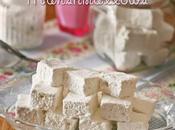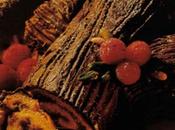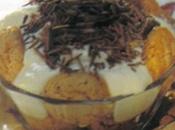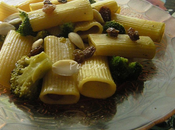Terza puntata…
Il precedente racconto si è interrotto a Montedinove dove abbiamo incontrato la Mela Rosa dei Monti Sibillini, e dove abbiamo avuto modo di degustare alcuni dei piatti tipici e di apprezzare alcuni dei grandi vini del Piceno.
E’ risaputo che nel Piceno il paesaggio collinare, alle spalle del mare, offre panorami suggestivi con i suoi estesi vigneti che producono grandi vini di eccellenza sia bianchi che rossi.

La tradizione…
Qui la viticultura ha origini antichissime e oggi per il recupero della tradizione e della qualità si va alla riscoperta e al recupero di antichi vitigni autoctoni di grande carattere che erano stati, negli anni, quasi completamente dimenticati.
L’esempio più classico è quello del Pecorino un vino che è stato quasi completamente dimenticato e solo negli ultimi anni è stato rivalutato grazie alla scoperta di vecchie piante secolari nelle zone montane di Arquata del Tronto.
L’innovazione…
Al recupero della tradizione vitivinicola con la riscoperta delle viti autoctone del Passerina e del Pecorino, si affianca l’esigenza, da parte dei produttori, di trovare nuovi processi produttivi per la vinificazione e per l’invecchiamento dei vini e questo porta, ancor più, ad una maggior rivalutazione del territorio e dei suoi vini.
I vini del Piceno che possono fregiarsi della denominazione DOC sono:
- Falerio DOC. è un vino bianco dal sapore leggermente acidulo, secco e sapido, dal colore giallo paglierino con riflessi dorati.
Ha dei profumi gradevoli che evocano le mele e i fiorellini bianchi di prato. Per la sua freschezza è un vino adatto per gli aperitivi a base di pesce, per tutti i piatti di pesce, per le olive all’ascolana ripiene e fritte e per tutte le verdure e gli ortaggi.
E’ un vino che non va invecchiato quindi deve essere bevuto nel primo anno di vita e per meglio degustarne le qualità va bevuto ad una temperatura di 8°-10° C.
La DOC Falerio, fu istituita nel 1975 e fu modificata una prima volta nel 1997 e successivamente nel 2003.
Per la sua preparazione si utilizzano le uve di Trebbiano Toscano (20%-50%), Passerina (10%-30%), Pecorino (10%-30%) e fino a un massimo del 20% di altre varietà di uva bianca, raccomandate o autorizzate dalla Provincia di Ascoli
Il suo nome è legato alle origini della storia del Piceno: deriva da Faleria, un’antica città romana oggi conosciuta col nome di Falerone.
- Rosso Piceno DOC è un vino rosso dal profumo intenso, molto fruttato con un sottile sentore speziato.
E’ di un bel colore rosso rubino intenso con riflessi violacei eh ha il gusto asciutto e armonioso, morbido.
Per la sua corposità è un vino che si abbina bene a minestre e bolliti, a piatti succulenti a base di carni rosse, ai salumi e formaggi stagionati e un po’ piccanti.
Va servito a una temperatura di 16°-18°C. negli appositi ampi calici
Per la sua preparazione si usano in pari quantità uve Sangiovese e Montepulciano
- Rosso Piceno Superiore DOC è prodotto in una ristretta area tra Ascoli Piceno e S. Benedetto del Tronto; è un vino corposo, dal colore intenso e dai profumi di prugna e liquirizia che ne fanno un vino ottimo. Molto adatto per un lungo invecchiamento è adatto ai secondi piatti a base di carni d’agnello, di coniglio, di selvaggina, o ai formaggi stagionati, come i pecorini della zona e ai tartufi.
Va servito a 16°-18°C in calici ampi, per apprezzarne al meglio i profumi.
Nella DOC di Offida, che porta il nome dell’omonimo comune, si producono:
- Offida Rosso DOC: ottenuto da uve Montepulciano (minimo 50%) che gli conferiscono forza e da uve Cabernet Sauvignon (30%) che gli danno una maggiore amabilità con l’ eventuale aggiunta di altre uve rosse prodotte nel territorio stesso è un vino equilibrato che si contraddistingue per la sua capacità di durare nel tempo.
Il Disciplinare di produzione di questo vino prevede che sia invecchiato per 24 mesi, di cui 6 in legno, e che l’invecchiamento inizi a partire dal mese di dicembre successivo alla vendemmia.
E’ un vino che abbina bene con le carni, con primi piatti sostanziosi a base di ragù e con formaggi a lunga stagionatura, ed è ottimo con i piatti di carne tipici del territorio.
- Offida Passerina DOC : è un vino bianco dal profumo fresco, floreale che ricorda la frutta tropicale. e dal colore giallo paglierino con riflessi verdognoli. Si consuma abbastanza giovane, possibilmente entro il secondo anno di vita. Si abbina bene con frutti di mare e crostacei e con le carni bianche
Va servito alla temperatura di 8°-10° C.
Ottenuto da uve bianche monovitigno ( 85%) si presenta fermo, spumante e Passito.
Nella versione ferma si apprezza tutto il patrimonio acidico tipico di quest’uva e la delicatezza dei profumi.
Nella versione spumante si abbina bene con il pesce, con i molluschi, con i crostacei o le olive all’ascolana. Nella versione spumantizzata, la piacevolezza delle bollicine rende ancora più godibile la freschezza di questo vino,
Nella versione Passito si esaltano la sua dolcezza e la sua setosità che lo rendono particolarmente adatto ai dolci, in particolare a quelli all’anice
La Disciplinare prevede he per la sua preparazione vengano utilizzate uve Passerina per almeno l’85%. Possono concorrere alla produzione anche altri vitigni a bacca bianca, non aromatici, raccomandati e/o autorizzati per la provincia di Ascoli Piceno fino a un massimo del 15%.
Le origini del nome di questo vitigno sono sconosciute: di recente, grazie alla riscoperta dei vitigni autoctoni, si è cominciato a vinificarlo in purezza valorizzandone al meglio le sue caratteristiche organolettiche.
- Offida Pecorino DOC è un vino di colore giallo paglierino con riflessi verdognoli, dal profumo floreale, con sentori che i fiori di acacia, di frutta fresca , e con una predominanza di frutti esotici.
Il gusto è morbido con note che talvolta che richiamano gli agrumi, altre che ricordano, la liquirizia.
Il sapore pieno resiste a lungo, il vino Pecorino si abbina bene con un pranzo a base di pesce, di carni bianche, ma si abbina bene anche ai risotti e ai formaggi.
E’ un vino bianco di carattere con un alto tenore zuccherino che gli conferisce una gradazione alcolica, sempre al di sopra dei 13°, corposo e con un elevato tenore acidico.
La riscoperta di questo vitigno, ha permesso di far conoscere le peculiarità di questo vino che, precedentemente, non veniva vinificato in purezza.
Il disciplinare prevede che venga prodotto con uve Pecorino per almeno l’85%. Possono concorrere alla produzione altri vitigni a bacca bianca, non aromatici, raccomandati e/o autorizzati per la provincia di Ascoli Piceno fino a un massimo del 15%.
I 5 sensi nelle Cantine del Piceno…
E proprio nelle cantine e in tavola che i vini del Piceno coinvolgono i nostri 5 sensi e ci permettono di vivere delle esperienze sensoriali veramente uniche e particolari
la vista: dei vini sia rossi che bianchi cogliamo il colore, i riflessi e le sfumature e la limpidezza,
l’udito: dei vini, in particolare quelli spumatati, cogliamo l’effervescenza
l’olfatto: dei vini cogliamo il profumo, l’ aroma, il bouquet: percepiamo i suoi odori che vanno dal fruttato, al floreale, allo speziato, all’ aromatico, al balsamico, al tostato, al legnoso.
il gusto: dei vini le nostre papille gustative percepiscono i diversi sapori che ne compongono il gusto e che vanno dal dolce (degli zuccheri e dell’alcol), all’acido (dei vini bianchi secchi), all’amaro (dato da alcune sostanze aromatiche presenti nel vino e all’’ossidazione dei tannini) al salmastro dei vini bianchi prodotti nelle zone marine.
il tatto: dei vini cogliamo la consistenza, e la fluidità
Le cantine di EATING PICENO:
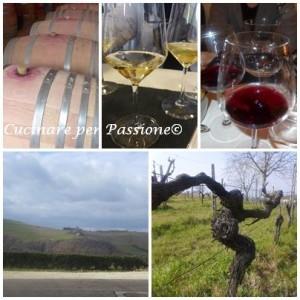
TENUTE DEL BORGO di Cossignano : http://www.tenutedelborgo.it/
DIANETTI VINI di Carassai : http://www.dianettivini.it
TENUTA VALLORANI di Colli del Tronto: http://www.vignetivallorani.com/
CANTINA FIORANO di Cossignano: http://www.agrifiorano.it
CANTINA LA CANOSA di Rotella http://www.lacanosaagricola.it
AZIENDA AGRICOLA CAMILLO PEROZZI di San Savino di Ripatransone tel. 0735/90112
AZIENDA PANTALEONE di Ascoli Piceno: http://www.pantaleonewine.it
E con uno di questi vini, il Rosso Piceno doc. prepariamo uno dei piatti più tipici della tradizione delle Marche e del Piceno è una di quelle specialità che abbiamo degustato durante il tour al Ristorante Country House San Giorgio Frazione Rosara 88 Ascoli Piceno
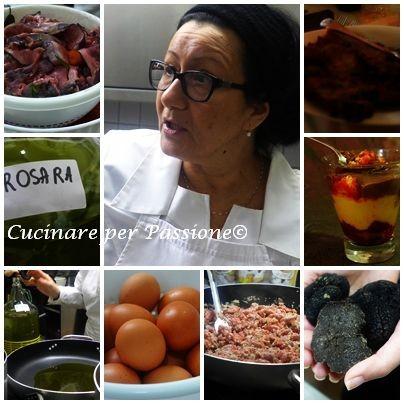
le pappardelle con il ragù di cinghiale
Ingredienti per la pasta:400 gr. di farina, 4 uova, sale.
Ingredienti per il ragù: 400 gr. di carne di cinghiale, 3 spicchi di aglio, 1 cipolla, 1 carota, 1 costa di sedano, rosmarino, prezzemolo, salvia, maggiorana, timo, basilico, finocchio selvatico, bacche di ginepro, chiodi di garofano, 1 bottiglia di vino rosso corposo ( Rosso Piceno Doc. ) , ½ bicchiere di brandy, passata di pomodoro, olio extravergine di oliva, pepe nero in grani, parmigiano e pecorino grattugiati.
In una terrina metto a marinare per una notte la carne di cinghiale tagliata a pezzettini con il vino ed un trito di odori. Trascorso il tempo detto la scolo, e la faccio rosolare in una casseruola con l’ olio e l’ aglio. Sfumo quindi con il cognac ed aggiungere un po’ di acqua che faccio evaporare lentamente a pentola scoperta. Aggiungo un trito di erbe aromatiche, la passata di pomodoro e la faccio cuocere a fuoco basso per almeno due ore.
Sulla spianatoia verso a fontana la farina passata al setaccio, e le rompo dentro le uova e un pizzico di sale. Lavoro con forza fino ad ottenere un impasto liscio e consistente. Formo un panetto, lo avvolgo in un panno inumidito e lo faccio riposare per circa un’ora; poi con il mattarello tiro una sfoglia sottile, che avvolgo su se stessa e taglio in quadrati di circa 15 cm. di lato che faccio cuocere pochi alla volta in abbondante acqua salata in ebollizione per 2 minuti e li scolo sopra telo.
Lesso e scolo le pappardelle e le condisco con il ragù preparato e una abbondante spolverata di parmigiano grattugiato.
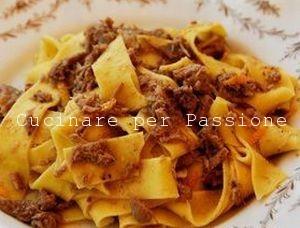
Buon appetito e se volete saperne di più ci vediamo presto…


**********
English version…
# Eatingpiceno: along the SP514 to discover the great wines and wineries of the Terre del Piceno.
Third episode …
The previous story was interrupted in Montedinove where we met the Mela Rosa dei Monti Sibillini, and where we got to taste some of the traditional dishes and enjoy some of the great wines of the Piceno.
It is well known that in the Piceno the hilly panorama, overlooking the sea, offers beautiful views with its extensive vineyards producing great wines of excellence both white and red.
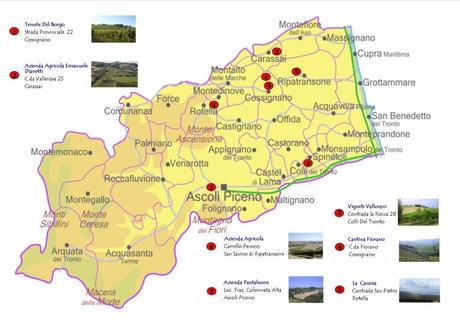
The tradition …
Here the viticulture has ancient origins and today in order to recover the tradition and quality we go to rediscover the ancient vines of great character which have been, over the years, almost completely forgotten.
The most classic example is that of the Pecorino, a wine that has been almost completely forgotten and only in recent years has been upgraded thanks to the discovery of century old trees in the mountain areas of Arquata del Tronto.
The innovation …
With the recovery of the winemaking tradition and the rediscovery of the native vines of the Passerina and the Pecorino, the producers need to find new manufacturing processes for the fermentation and aging of these wines and this brings an even greater appreciation of the region and its wine.
The wines of the Piceno which can proudly carry the label DOC are:
- Ÿ Falerio DOC. it is a white wine with a slightly sour, dry and full-bodied taste, yellow straw colour with golden reflections.
It has pleasant scents which evoke apples and white meadow flowers. Its freshness makes it a suitable wine for aperitifs with fish, for all fish dishes, for “olive all’ascolana” stuffed fried olives of Ascoli, and for all types of vegetables.
It is a wine which does not need to be aged therefore it must be drunk in the first year of its life, and to improve the quality it should be drunk at a temperature of 8 ° -10 ° C.
The DOC Falerio, was established in 1975 and was first amended in 1997 and then later in 2003.
It is prepared using a combination of the grapes of Trebbiano Toscano (20% -50%), Passerina (10% -30%), Pecorino (10% -30%) and up to a maximum of 20% of other varieties of white grapes, recommended or authorized by the Province of Ascoli.
Its name is linked to the origins of the history of Piceno: it derives from Faleria, an ancient Roman city known today as Falerone.
- Ÿ Rosso Piceno DOC is a red wine with an intense aroma, very fruity with a subtle spicy scent.
It has a beautiful deep ruby red colour with violet hues with a dry, well-proportioned soft taste.
Because of its body is a wine that goes well with soups and stews, with succulent dishes with red meat, cold cuts and slightly spicy cheeses.
It should be served at a temperature of 16 ° -18 ° C. in appropriate large wine glasses.
For its preparation Sangiovese and Montepulciano grapes are used in equal amounts.
- Ÿ Rosso Piceno Superiore DOC is produced in a small area between Ascoli Piceno and S. Benedetto del Tronto, it is a full-bodied wine, with an intense colour and the aromas of plum and liquorice which make it an excellent wine. Very suitable for long aging, it is suitable for main dishes such as lamb, rabbit, game or for matured cheeses such as pecorino from this area and truffles.
It should be served at 16 ° -18 ° C in large wine glasses to appreciate the scents fully.
In the DOC of Offida, which bears the name of its Municipality, the following are produced:
- Ÿ Offida Rosso DOC made from Montepulciano grapes (minimum 50%) which bestow strength and from Cabernet Sauvignon grapes (30%) which give a greater aroma with the optional addition of other red grapes grown in the same area it is a balanced wine which is characterized by its ability to stand the test of time.
The regulation of production of this wine foresees that it is aged for 24 months, 6 of which in wood, and that its aging process starts from the month of December following the harvest.
It is a wine that goes well with meat, with first courses based on ragù sauce and well matured cheese. It also goes well with meat dishes typical of this region.
- Ÿ Offida Passerina DOC It is a white wine with a fresh scent, floral, reminiscent of tropical fruit and a pale yellow colour with greenish reflections. It is to be drunk while quite young, possibly within the second year of life. It goes well with seafood, shellfish and white meats
Serve at a temperature of 8 ° -10 ° C.
Obtained from single-varietal white grapes (85%) it is presented still, sparkling and Passito.
In the still version you can appreciate all the acidic heritage typical of this grape and its delicate perfumes.
The spumante version goes well with fish, various types of shellfish, or with stuffed olives. In the spumante version, the pleasantness of the bubbles makes the freshness of this wine even more enjoyable.
The Passito version enhances its sweetness and smoothness which make it particularly suitable for desserts, especially those with aniseed.
The regulation which foresees at least 85% Passerina grapes for its preparation and also other white grape varieties, non-aromatic, recommended and / or authorized by the province of Ascoli Piceno, up to a maximum of 15% can be used.
The origins of the name of this variety are unknown: Recently, thanks to the rediscovery of these native grapes, they have begun this single-variety vinification emphasizing its most organoleptic characteristics.
- Ÿ Offida Pecorino DOC is a wine with a yellow straw colour with greenish hues, a floral aroma, with hints of acacia flowers, fresh fruit, and a preponderance of exotic fruits.
The taste is smooth with notes of citrus fruit, others of liquorice.
The full flavour lasts a while, Pecorino wine goes well with a lunch based on fish or white meat, but it also goes well with rice and cheese.
It is a white wine with character, full-bodied with a high acidic content and its high sugar content maintains the alcoholic content above 13°.
The rediscovery of this vine, has helped us to get acquainted with the peculiarities of this wine which was previously made with single variety grapes.
The regulation foresees that it is produced with Pecorino grapes for at least 85%. Other non-aromatic white berry grape varieties which are recommended and / or authorized by the province of Ascoli Piceno can be used but only up to a maximum of 15%.
The 5 senses in the Wine Cellars of Piceno …
It is in the wine cellars and at the table that the wines of Piceno involve our five senses and allow us to live sensory experiences which are truly special and unique:
sight: of both the red and white wines we admire the colour, the reflections, the hues and the clarity.
hearing: of the wines, particularly the spumantes, we admire the fizziness.
smell: of the wines we appreciate the aroma, the bouquet: we perceive the smells ranging from fruity, floral, spicy, aromatic, balsamic, to toasted, to woody.
taste: of the wines our taste buds perceive the different flavours that compose the taste ranging from sweet (sugar and alcohol), acid (dry white wines), bitter (given by some of the aromatic substances in wine and the oxidation of the tannin) of the salty white wines produced in marine areas.
touch: of the wines we admire the consistency and the fluidity.
The cellars of EATING PICENO:
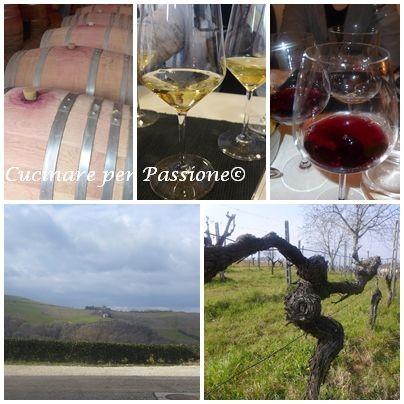
TENUTE DEL BORGO of Cossignano: http://www.tenutedelborgo.it/
DIANETTI VINI of Carassai: http://www.dianettivini.it
TENUTA VALLORANI of Colli del Tronto: http://www.vignetivallorani.com/
CANTINA FIORANO of Casaignano: http://www.agrifiorano.it
CANTINA LA CANOSA of Rotella http://www.lacanosaagricola.it
AZIENDA AGRICOLA CAMILLO PEROZZI of San Savino of Ripatransone: tel. 0735/90112
AZIENDA PANTALEONE of Ascoli Piceno: http://www.pantaleonewine.it
And it is with one of these wines, the Rosso Piceno DOC. that we prepare one of the most typical dishes from the tradition of the Marche and the Piceno, and it is one of those dishes that we tasted during the tour at the Ristorante Country House San Giorgio, Frazione Rosara 88 Ascoli Piceno
pappardelle with wild boar ragu’…
Ingredients for the pasta: 400 gr. of flour, 4 eggs, salt.
Ingredients for the ragu‘: 400 gr. wild boar meat, 3 cloves of garlic, 1 onion, 1 carrot, 1 stick of celery, rosemary, parsley, sage, marjoram, thyme, basil, wild fennel, juniper berries, cloves, 1 bottle of full bodied red wine (Rosso Piceno DOC), ½ glass of brandy, tomato sauce, extra virgin olive oil, black pepper, grated parmesan and pecorino cheese.
Cut the wild boar meat into small pieces and marinate overnight in a bowl with the wine and chopped herbs. After marinating, drain the meat and pan fry in a saucepan with the oil and garlic. Add the cognac and a little water which will evaporate slowly in the open saucepan. Add the aromatic herbs, tomato sauce and then cook over a low heat for at least two hours.
Onto the pastry board pour the sifted flour, and break in the eggs and a pinch of salt. Work hard until the dough is smooth and consistent. Form a ball, wrap it in a damp cloth and let it sit for about an hour; then with a rolling pin roll the dough into a thin strip, which we roll up on itself and cut into squares about 15 cm in width which we will cook a few at a time in plenty of boiling salted water for 2 minutes, then drain them on a piece of canvas.
Boil and drain the pappardelle and season with the prepared ragu’ and a generous sprinkling of grated parmesan and pecorino cheese.

Enjoy and if you want to know more … see you soon


